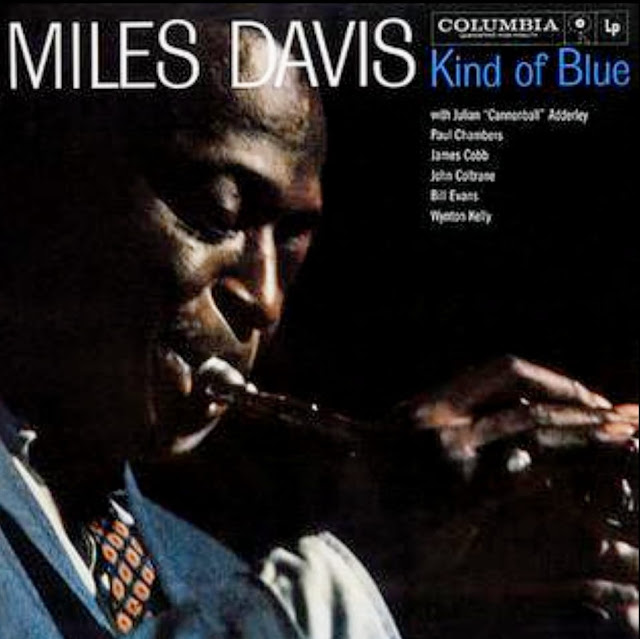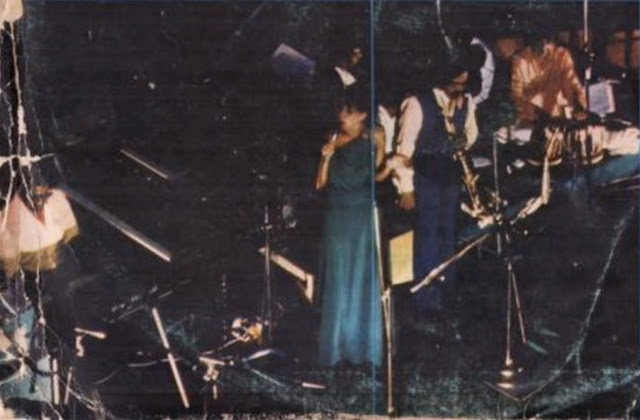MILES DAVIS 60th Anniversary
Miles Davis' studio album Kind of Blue is widely regarded as one of
the greatest musical statements of the 20th century, the definitive album that
changed the face of music itself.

Besides Miles on
trumpet his sextet comprises tenor saxophonist John Coltrane, alto saxophonist Julian 'Cannonball' Adderley, drummer Jimmy Cobb, bassist Paul
Chambers and pianist Bill Evans (resident Wynton Kelly plays piano
on Freddy Freeloader).
Each of these
players of what was probably the greatest jazz ensemble ever, would have
legendary careers.
The five tracks were recorded on
March 2nd and April 22nd, 1959, at Columbia's 30th Street Studio in New York
City, and released on August 17 of that year by Columbia Records.
This peerless innovative,
sophisticated masterpiece is regarded as one of the best records of all time,
the pioneer of modal jazz, a music free of the fixed harmonies and forms,
one that becomes weightless in these cat's hands.
John Coltrane displays his free, unorthodox, intense tonal style and Miles Davis balances it with contrasting smoothness and sparse phrasing. Julian 'Cannonball' Adderley's alto colors John Coltrane's tenor with daring rhythm in his own more melodic style, characteristic of his traditional, ebullient phrasing. Bill Evans, solo or accompanying, glides profoundly elegant on the driving yet laid back swing of Jimmy Cobb. Paul Chambers plays the technically dynamic and harmonic foundation of the sextet, his exceptional skill leading a tight rhythm section. In the process we hear every creative counter-position imaginable.
The album's influence on jazz, rock and classical music has led aficionados to consider it one of the most influential recordings ever. In his sleeve notes Bill Evans says the band did not play through any of the material on the album prior to the actual recordings; Miles laid out the themes and chords and the band then improvised. The result was a cornerstone for any musical reference that entertains on so many levels, a must in any collection.
John Coltrane displays his free, unorthodox, intense tonal style and Miles Davis balances it with contrasting smoothness and sparse phrasing. Julian 'Cannonball' Adderley's alto colors John Coltrane's tenor with daring rhythm in his own more melodic style, characteristic of his traditional, ebullient phrasing. Bill Evans, solo or accompanying, glides profoundly elegant on the driving yet laid back swing of Jimmy Cobb. Paul Chambers plays the technically dynamic and harmonic foundation of the sextet, his exceptional skill leading a tight rhythm section. In the process we hear every creative counter-position imaginable.
The album's influence on jazz, rock and classical music has led aficionados to consider it one of the most influential recordings ever. In his sleeve notes Bill Evans says the band did not play through any of the material on the album prior to the actual recordings; Miles laid out the themes and chords and the band then improvised. The result was a cornerstone for any musical reference that entertains on so many levels, a must in any collection.
KIND OF BLUE (50th Anniversary promo)
Freddie Freeloader (from Vinyl)
Although Miles was listed as the writer of all compositions
on the original issue many believed that Bill Evans wrote a part or the whole
of Blue in Green and Flamenco Sketches. Bill
assumed co-credit with Miles for Blue in Green when recording
it on his album Portrait in Jazz eight months later and the
Davis estate acknowledged Bill's authorship in 2002.
The Library of Congress added Kind Of Blue to the National Recording Registry in 2002 as one of fifty recordings chosen and in 2003 it was ranked 12th on Rolling Stone magazine's list of the 500 greatest albums of all time.
Kind of Blue is widely cited as the best-selling jazz record of all time. In 2008 it was certified quadruple platinum by the Recording Industry Association of America for sales of at least 4 million copies.
As virtuoso Herbie Hancock, one of Miles' collaborators in his second great quintet says, "If you want to hear the spirit of jazz listen to Kind Of Blue"
Sleeve Notes
IMPROVISATION IN JAZZ
by Bill Evans
There is a Japanese visual art in which the artist is forced to be spontaneous. He must paint on a thin stretched parchment with a special brush and black water paint in such a way that an unnatural or interrupted stroke will destroy the line or break through the parchment. Erasures or changes are impossible. These artists must practice a particular discipline, that of allowing the idea to express itself in communication with their hands in such a direct way that deliberation cannot interfere.
The resulting pictures lack the complex composition and textures of ordinary painting, but it is said that those who see well find something captured that escapes explanation.
This conviction that direct deed is the most meaningful reflections, I believe, has prompted the evolution of the extremely severe and unique disciplines of the jazz or improvising musician.
Group improvisation is a further challenge. Aside from the weighty technical problem of collective coherent thinking, there is the very human, even social need for sympathy from all members to bend for the common result. This most difficult problem, I think, is beautifully met and solved on this recording.
As the painter needs his framework of parchment, the improvising musical group needs its framework in time. Miles Davis presents here frameworks which are exquisite in their simplicity and yet contain all that is necessary to stimulate performance with sure reference to the primary conception.
Miles conceived these settings only hours before the recording dates and arrived with sketches which indicated to the group what was to be played. Therefore, you will hear something close to pure spontaneity in these performances. The group had never played these pieces prior to the recordings and I think without exception the first complete performance of each was a "take."
Although it is not uncommon for a jazz musician to be expected to improvise on new material at a recording session, the character of these pieces represents a particular challenge.
Briefly, the formal character of the five settings are: "So What" is a simple figure based on 16 measures of one scale, 8 of another and 8 more of the first, following a piano and bass introduction in free rhythmic style. "Freddie Freeloader" is a 12-measure blues form given new personality by effective melodic and rhythmic simplicity. "Blue in Green" is a 10-measure circular form following a 4-measure introduction, and played by soloists in various augmentation and diminution of time values. "All Blues" is a 6/8 12-measure blues form that produces its mood through only a few modal changes and Miles Davis' free melodic conception. "Flamenco Sketches" is a series of five scales, each to be played as long as the soloist wishes until he has completed the series.
The Library of Congress added Kind Of Blue to the National Recording Registry in 2002 as one of fifty recordings chosen and in 2003 it was ranked 12th on Rolling Stone magazine's list of the 500 greatest albums of all time.
Kind of Blue is widely cited as the best-selling jazz record of all time. In 2008 it was certified quadruple platinum by the Recording Industry Association of America for sales of at least 4 million copies.
As virtuoso Herbie Hancock, one of Miles' collaborators in his second great quintet says, "If you want to hear the spirit of jazz listen to Kind Of Blue"
Sleeve Notes
IMPROVISATION IN JAZZ
by Bill Evans
There is a Japanese visual art in which the artist is forced to be spontaneous. He must paint on a thin stretched parchment with a special brush and black water paint in such a way that an unnatural or interrupted stroke will destroy the line or break through the parchment. Erasures or changes are impossible. These artists must practice a particular discipline, that of allowing the idea to express itself in communication with their hands in such a direct way that deliberation cannot interfere.
The resulting pictures lack the complex composition and textures of ordinary painting, but it is said that those who see well find something captured that escapes explanation.
This conviction that direct deed is the most meaningful reflections, I believe, has prompted the evolution of the extremely severe and unique disciplines of the jazz or improvising musician.
Group improvisation is a further challenge. Aside from the weighty technical problem of collective coherent thinking, there is the very human, even social need for sympathy from all members to bend for the common result. This most difficult problem, I think, is beautifully met and solved on this recording.
As the painter needs his framework of parchment, the improvising musical group needs its framework in time. Miles Davis presents here frameworks which are exquisite in their simplicity and yet contain all that is necessary to stimulate performance with sure reference to the primary conception.
Miles conceived these settings only hours before the recording dates and arrived with sketches which indicated to the group what was to be played. Therefore, you will hear something close to pure spontaneity in these performances. The group had never played these pieces prior to the recordings and I think without exception the first complete performance of each was a "take."
Although it is not uncommon for a jazz musician to be expected to improvise on new material at a recording session, the character of these pieces represents a particular challenge.
Briefly, the formal character of the five settings are: "So What" is a simple figure based on 16 measures of one scale, 8 of another and 8 more of the first, following a piano and bass introduction in free rhythmic style. "Freddie Freeloader" is a 12-measure blues form given new personality by effective melodic and rhythmic simplicity. "Blue in Green" is a 10-measure circular form following a 4-measure introduction, and played by soloists in various augmentation and diminution of time values. "All Blues" is a 6/8 12-measure blues form that produces its mood through only a few modal changes and Miles Davis' free melodic conception. "Flamenco Sketches" is a series of five scales, each to be played as long as the soloist wishes until he has completed the series.



Comments
Post a Comment